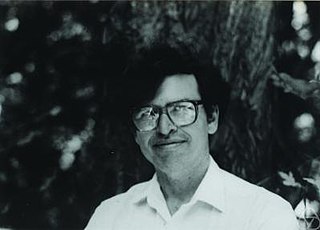Related Research Articles

William Paul Thurston was an American mathematician. He was a pioneer in the field of low-dimensional topology and was awarded the Fields Medal in 1982 for his contributions to the study of 3-manifolds.

In mathematics, low-dimensional topology is the branch of topology that studies manifolds, or more generally topological spaces, of four or fewer dimensions. Representative topics are the structure theory of 3-manifolds and 4-manifolds, knot theory, and braid groups. This can be regarded as a part of geometric topology. It may also be used to refer to the study of topological spaces of dimension 1, though this is more typically considered part of continuum theory.

In mathematics, a 3-manifold is a topological space that locally looks like a three-dimensional Euclidean space. A 3-manifold can be thought of as a possible shape of the universe. Just as a sphere looks like a plane to a small and close enough observer, all 3-manifolds look like our universe does to a small enough observer. This is made more precise in the definition below.
In mathematics, more precisely in topology and differential geometry, a hyperbolic 3-manifold is a manifold of dimension 3 equipped with a hyperbolic metric, that is a Riemannian metric which has all its sectional curvatures equal to −1. It is generally required that this metric be also complete: in this case the manifold can be realised as a quotient of the 3-dimensional hyperbolic space by a discrete group of isometries.

In mathematics, a Kleinian group is a discrete subgroup of the group of orientation-preserving isometries of hyperbolic 3-space H3. The latter, identifiable with PSL(2, C), is the quotient group of the 2 by 2 complex matrices of determinant 1 by their center, which consists of the identity matrix and its product by −1. PSL(2, C) has a natural representation as orientation-preserving conformal transformations of the Riemann sphere, and as orientation-preserving conformal transformations of the open unit ball B3 in R3. The group of Möbius transformations is also related as the non-orientation-preserving isometry group of H3, PGL(2, C). So, a Kleinian group can be regarded as a discrete subgroup acting on one of these spaces.
In the mathematical subfield of 3-manifolds, the virtually fibered conjecture, formulated by American mathematician William Thurston, states that every closed, irreducible, atoroidal 3-manifold with infinite fundamental group has a finite cover which is a surface bundle over the circle.
In mathematics, hyperbolic Dehn surgery is an operation by which one can obtain further hyperbolic 3-manifolds from a given cusped hyperbolic 3-manifold. Hyperbolic Dehn surgery exists only in dimension three and is one which distinguishes hyperbolic geometry in three dimensions from other dimensions.
In topology, an area of mathematics, the virtually Haken conjecture states that every compact, orientable, irreducible three-dimensional manifold with infinite fundamental group is virtually Haken. That is, it has a finite cover that is a Haken manifold.
David Gabai is an American mathematician and the Hughes-Rogers Professor of Mathematics at Princeton University. His research focuses on low-dimensional topology and hyperbolic geometry.

In the mathematical field of knot theory, the hyperbolic volume of a hyperbolic link is the volume of the link's complement with respect to its complete hyperbolic metric. The volume is necessarily a finite real number, and is a topological invariant of the link. As a link invariant, it was first studied by William Thurston in connection with his geometrization conjecture.
In mathematics, more precisely in group theory and hyperbolic geometry, Arithmetic Kleinian groups are a special class of Kleinian groups constructed using orders in quaternion algebras. They are particular instances of arithmetic groups. An arithmetic hyperbolic three-manifold is the quotient of hyperbolic space by an arithmetic Kleinian group.
James W. Cannon is an American mathematician working in the areas of low-dimensional topology and geometric group theory. He was an Orson Pratt Professor of Mathematics at Brigham Young University.

Danny Matthew Cornelius Calegari is a mathematician and, as of 2023, a professor of mathematics at the University of Chicago. His research interests include geometry, dynamical systems, low-dimensional topology, and geometric group theory.
In hyperbolic geometry, the ending lamination theorem, originally conjectured by William Thurston as the eleventh problem out of his twenty-four questions, states that hyperbolic 3-manifolds with finitely generated fundamental groups are determined by their topology together with certain "end invariants", which are geodesic laminations on some surfaces in the boundary of the manifold.
The geometry and topology of three-manifolds is a set of widely circulated notes for a graduate course taught at Princeton University by William Thurston from 1978 to 1980 describing his work on 3-manifolds. They were written by Thurston, assisted by students William Floyd and Steven Kerchoff. The notes introduced several new ideas into geometric topology, including orbifolds, pleated manifolds, and train tracks.
In mathematics, the Ahlfors conjecture, now a theorem, states that the limit set of a finitely-generated Kleinian group is either the whole Riemann sphere, or has measure 0.
In geometry, a tame manifold is a manifold with a well-behaved compactification. More precisely, a manifold is called tame if it is homeomorphic to a compact manifold with a closed subset of the boundary removed.

Ian Agol is an American mathematician who deals primarily with the topology of three-dimensional manifolds.

Jeffrey Farlowe Brock is an American mathematician, working in low-dimensional geometry and topology. He is known for his contributions to the understanding of hyperbolic 3-manifolds and the geometry of Teichmüller spaces.
Albert Marden is an American mathematician, specializing in complex analysis and hyperbolic geometry.
References
- Agol, Ian (2004), Tameness of hyperbolic 3-manifolds, arXiv: math.GT/0405568 , Bibcode:2004math......5568A .
- Calegari, Danny; Gabai, David (2006), "Shrinkwrapping and the taming of hyperbolic 3-manifolds", Journal of the American Mathematical Society , 19 (2): 385–446, arXiv: math/0407161 , doi:10.1090/S0894-0347-05-00513-8, MR 2188131 .
- Gabai, David (2009), "Hyperbolic geometry and 3-manifold topology", in Mrowka, Tomasz S.; Ozsváth, Peter S. (eds.), Low Dimensional Topology, IAS/Park City Math. Ser., vol. 15, Providence, R.I.: American Mathematical Society, pp. 73–103, ISBN 978-0-8218-8696-0, MR 2503493
- Mackenzie, Dana (2004), "Taming the hyperbolic jungle by pruning its unruly edges", Science , 306 (5705): 2182–2183, doi:10.1126/science.306.5705.2182, PMID 15618501 .
- Marden, Albert (1974), "The geometry of finitely generated kleinian groups", Annals of Mathematics , Second Series, 99 (3): 383–462, doi:10.2307/1971059, ISSN 0003-486X, JSTOR 1971059, MR 0349992, Zbl 0282.30014
- Marden, Albert (2007), Outer Circles: An introduction to hyperbolic 3-manifolds, Cambridge University Press, ISBN 978-0-521-83974-7, MR 2355387 .